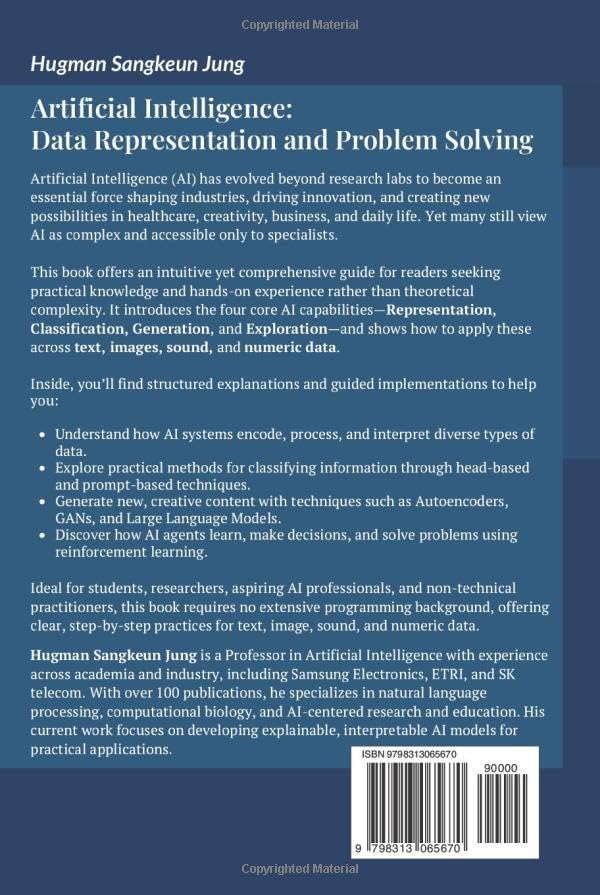Artificial Intelligence is no longer a futuristic concept reserved for tech-savvy specialists. It has entered the mainstream, influencing a myriad of sectors from healthcare to business. For those looking to demystify this complex field, "Artificial Intelligence: Data Representation and Problem Solving" serves as an invaluable resource. This book offers a comprehensive guide tailored for readers seeking practical knowledge and hands-on experience in AI, rather than being bogged down by theoretical jargon.

Key Features
The book introduces four core AI capabilities: Representation, Classification, Generation, and Exploration. Each of these concepts is critical in understanding how AI interacts with various forms of data, transforming complexity into clarity.
-
Data Representation: Readers learn how AI systems encode and interpret different types of data—text, images, sound, and numeric formats. This foundational knowledge is essential because understanding data representation is crucial for effective AI application.
-
Classification Techniques: The book offers practical methods for classifying information. It discusses both head-based and prompt-based techniques, equipping readers with the tools needed to categorize complex data efficiently.
-
Content Generation: It delves into advanced topics like Autoencoders, Generative Adversarial Networks (GANs), and Large Language Models, all pivotal for generating new, creative content. These techniques showcase the innovative side of AI, where machines can produce rather than just analyze.
-
Reinforcement Learning: The exploration of how AI agents learn, make decisions, and solve problems adds another layer of practical understanding. Reinforcement learning is a growing field within AI that mimics how humans learn from their environment, making this section particularly engaging and relevant.
By the end of the book, readers will not only grasp the theoretical frameworks but will also gain hands-on experience in implementing these AI capabilities.
Pros & Cons
Pros
- Accessibility: One of the standout features of "Artificial Intelligence: Data Representation and Problem Solving" is its accessibility. It is designed for those without an extensive programming background, effectively lowering the barrier to entry for aspiring AI professionals.
- Practical Focus: The book prioritizes practical applications and guided implementations, allowing readers to apply their knowledge in real-world scenarios.
- Comprehensive Approach: Covering a wide range of data types and AI techniques gives readers a well-rounded perspective of the field.
Cons
- Depth of Content: While it is beginner-friendly, some seasoned AI practitioners might find the content lacks depth in certain complex areas.
- No Programming Focus: Those looking for a book heavy on programming techniques may need to seek additional resources, as the emphasis here is on conceptual understanding rather than coding.
Who Is It For?
"Artificial Intelligence: Data Representation and Problem Solving" is ideal for a diverse audience. It caters to:
- Students: Those pursuing degrees in data science, computer science, or related fields will find this book helpful as an introductory text.
- Researchers: It provides a solid foundation for those looking to branch out into the practical applications of AI.
- Aspiring AI Professionals: The practical knowledge and hands-on experience make it a great start for anyone looking to launch their career in AI.
- Non-Technical Practitioners: Business leaders and creatives interested in leveraging AI for innovation will benefit from the clear and accessible teaching style.
Explore Data Representation Techniques
Final Thoughts
In an age where AI influences every facet of our lives, "Artificial Intelligence: Data Representation and Problem Solving" stands out as a crucial tool for those eager to explore this technology. Its intuitive structure and focus on practical knowledge make it an excellent starting point for beginners while still offering valuable insights for more experienced readers. By breaking down complex topics into digestible formats, this book promotes a collaborative view of AI, encouraging readers to see these technologies as partners in problem-solving rather than merely technical tools. Whether you're a student, researcher, or a curious mind, this book is a reliable resource to unlock the potential of AI in real-world applications.
Boost Your Problem Solving Skills in AI!
As an Amazon Associate, I earn from qualifying purchases.
Comments
Post a Comment